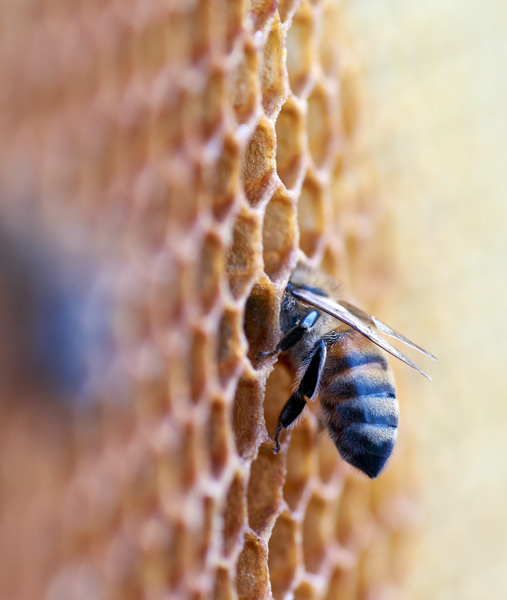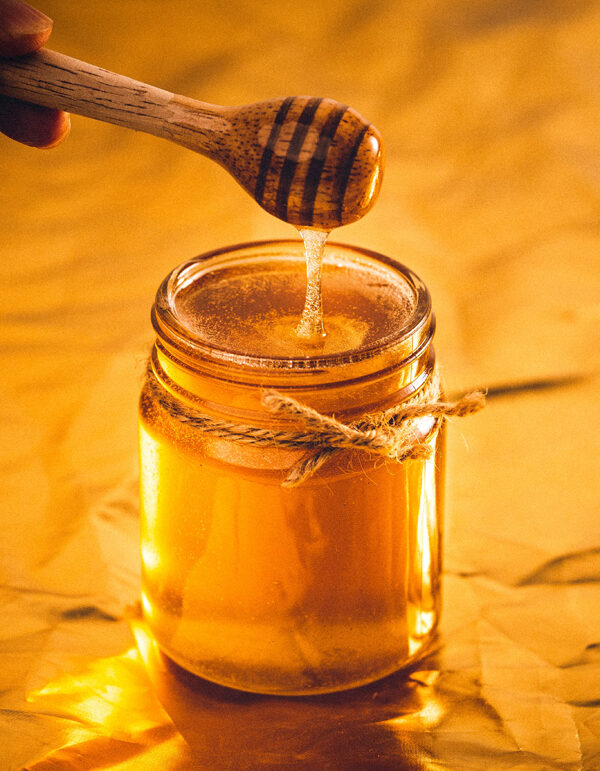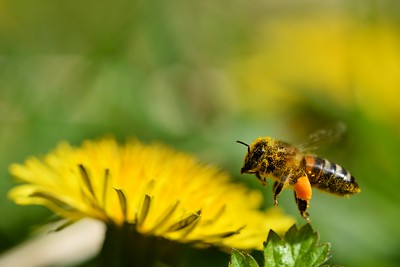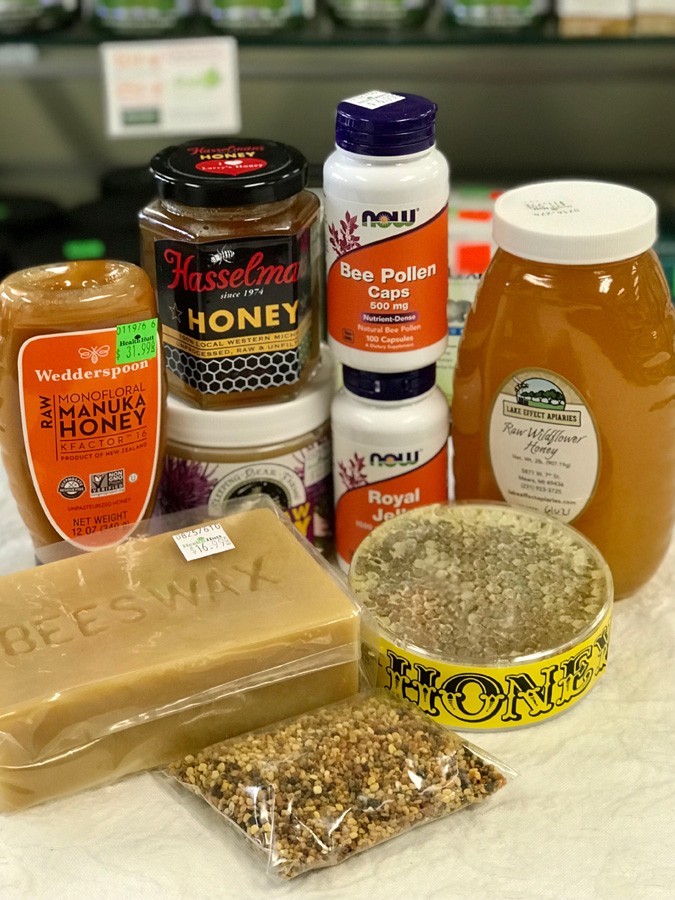In the process of creating and maintaining a hive, honey bees produce various products that humans have taken an interest in. The science and art of managing hives for bee products is called Apiculture. Though the world of bees and bee products is vast and intricate, in this post we explore the possible benefits of the primary bee products honey, bee pollen, and propolis and royal jelly.
Honey
Honey is known to be an energy-providing food and a healthier sweetener option. It is also often considered a functional food - meaning it has the potential to promote additional physiological and psychological health benefits in addition to basic nutrition. It’s the easiest bee product to acquire but still has many medicinal qualities!
Here’s how honey is made: The flower nectar that a honey-bee gathers interacts with enzymes in the bee’s stomach. Once the nectar has been regurgitated into wax cells of the combs, many bees then fan the nectar with their wings to aid evaporation and thicken it into what we call honey. (1)
Honey is a complex substance and contains enzymes, plant pigments, organic acids, esters, antibiotic agents, trace minerals; chrysin, quercetin, and kaempferol – among many other components. (1) The quality, nutritional value, medicinal attributes, and taste of honey varies depending on what flowers the bees collected from. For instance, the revered, and more expensive, manuka honey that you may have seen on shelves is from beehives in Australia and New Zealand made specifically from the nectar of the manuka tree. Manuka honey is known to have extremely high antibacterial activity. (3) Honey that is made primarily from one type of flower nectar takes on qualities of that nectar. Buckwheat honey is generally darker and richer in flavor, while neem honey may pass on benefits of neem to the consumer.
In general, raw, unprocessed, unpasteurized wildflower honey is a good choice. At the Health Hutt we carry a variety of honeys including monoflower honeys mentioned above and local wildflower honeys such as Hasselman's from Fremont area and Lake Effect from Mears.
Honey is a highly nutritive and healing substance that has been used for a variety of ailments. Traditionally, honey has been used to treat wounds, diseases of the gut (including gastric ulcers), cough, sore throat, and earaches (2). It has also been traditionally used to remedy insect bites, burns, skin disorders, sores, boils, eye infections, and respiratory conditions. (2)
One cure-all honey folk cure is to mix honey and cinnamon. This combination is purported to promote overall good health and remedy fatigue, bad breath, indigestion, upset stomach, toothaches, bladder infection. It can even be used topically with water to was the face and treat acne! Another duo, honey and milk, is thought to be good before going to bed and help sore throats. (3)
Honey has been shown scientifically to be beneficial in wound healing and management, oral health, gastrointestinal disorder, sore throat/strep, cough, dyspepsia, gastritis, gastroenteritis, peptic ulcer, constipation, and diarrhea. (2) Honey has been found to possess the following qualities: antibiotic, antiviral, anti-inflammatory, anticarcinogenic, expectorant, antiallergenic, laxative, antianemia, antifungal, immune stimulant, cardioprotective, gastroprotective and anticancer. (1)(2)
Fun fact: Today mead is a wine made with honey, but did you know that mead was once made with the whole hive? “That means everything went into the pot: wax, honey, propolis, bee pollen, royal jelly, and angry bees,” wrote Stephen Buhner in Sacred and Herbal Healing Beers.

Photo by Wolfgang Hasselmann on Unsplash

Photo by Art Rachen on Unsplash
Pollen
Bees have ‘baskets’ or hollow concave areas on their hind legs that they collect pollen with. The pollen from insect-pollinated plants is mixed with some nectar and digestive juices into a soft mass and placed into the baskets for transport to the hive where it is stored in the comb as additional an additional food source for the hive. (1)
Pollen grains, and therefore bee pollen, can vary in color greatly even though what we see in the store is either yellow, buff or orange. There are also purple, dark red, green, brown, and black pollens
Pollen is high in protein, of which honey does not contain enough to sustain the bees. Depending on the plant source the protein in pollen ranges from 8 to 40 percent. It is also exceptionally high in Rutin. (1) Pollen contains a high concentration of water-soluble vitamins including vitamins A, C, D, E, B1, B2, B6, niacin, biotin, inositol, and folic acids. Additionally, pollen contains minerals such as calcium, phosphorus, potassium, magnesium, iron, manganese, silicon, sulphur, chlorine, copper and zinc, as well as trace elements and amino acids. (1)

Photo by Gilles San Martin - CC BY-SA 2.0
Traditionally pollen has been used for its nutritive qualities. It has also been found to enhance energy and endurance when consume regularly. (1) Pollen has been found useful in the treatment of allergies, bacterial infections, asthma, capillary weakness, chronic fatigue, immune depression, menopausal symptoms, nutritional disorders, prostate health, chronic cystitis, and urinary tract infections. (1)
Pollen should be consumed as fresh as possible for maximum quality. It does not keep well as well as other bee products.
Propolis
Bees gather a gummy, resinous substance from the bark and leaves of living trees such as aspen, poplar, birch, elm, alder, horse chestnut, willow, pine and fir in North America. The tree resin is combined with nectar, pollen, wax, and bee enzymes to make propolis. Propolis is used by the bees as a hive sealant to patch holes, cracks and line the entrance of the hive. (1) Propolis protects the hive and colony by capturing contaminants and sterilizing bees as they return to the hive.
Propolis varies in color from light yellow-green to dark brown depending on what plants the bees collected materials from and the age of the propolis. (1)
The biological activities of propolis include antioxidant, antifungal, antidiabetic, antibacterial, antiprotozoan, anticancer, antitumoral, anti-inflammatory. (2) It has also been found to be antiallergenic, vulnerary, antiviral, antioxidant, antiseptic, and immune enhancing. (1) It has been used for gastrointestinal, gynecological care, oral health and dermatological care. (2)
Propolis is often put in toothpaste and mouthwashes because it can reduce growth of plague and pathogenic microflora that causes gingivitis and periodontitis. (2) It can also help prevent further decay from tooth cavities. (1) Propolis is also used in creams and ointments because of its antiallergy, antifungal, anti-inflammatory, and antimicrobial properties. It has been used in the treatment of skin diseases, herpes zoster, burns, and acne. (1) Propolis also has been shown to aid wound healing by increasing collagen content of tissues, especially helpful to promote wound closure. (2)
Pollen should be consumed as fresh as possible for maximum quality. It does not keep well as well as other bee products.

A top bar hive like this one allows bees to make their hive more like they would in nature. Photo by Jordan Schwartz under CC by 2.0
Fun Fact: The Balm of Gilead referred to in the Bible is propolis! Muslims refer to is as balsam Mecca.
Royal Jelly
Nurse bees, who are young worker bees, synthesize royal jelly from a diet of pollen and honey. Royal jelly, a thick milky substance, is fed directly to the queen bee and larvae that are to become queens. There is no difference between the queen bee and any other bee except that the queen bee exclusively eats royal jelly. A queen bee’s life expectancy is several years compared to the six weeks of an average worker bee!
While other bee products vary depending on region, royal jelly around the world appears to be the same in content. (1) Royal jelly contains bee pheromones, natural hormones, amino acids (including the 8 essential), B vitamins, nucleic acids, sugars, sterols, fatty acids, phosphorus compounds, and acetylcholine. (1)
Royal Jelly’s actions include antioxidant, antitumor, antiaging, neurotropic, and anti-inflammatory (2); antibacterial, antiviral, antitumor, tonic, nutritive, antiaging, euphoric, alterative, apathogenic, hormone normalizing, and antidepressant. (1)
It has been used for reproductive health, neurodegenerative diseases, and wound healing. (2) In fact, it targets almost all the bodily systems. Dr. H. W. Schmidt said, “Royal Jelly revives and stimulates the functions of cells and the secretions of glands. It also steps up the metabolism and stimulates the circulatory system. To summarize, … it works to preserve life and strength in the organism, … delays the aging process and helps the organism retain for as long as possible the physical freshness of the body, elasticity of the mind, and psychic buoyancy of youth.”
Conclusion
Bees truly are amazing creatures. It is a wonder how their products provide so many health benefits to humans. However, the quality of bee product depends on the environment and health of the hive. Ideally, bees have access to everything they need to maintain their hive. As an example, if there are not enough trees, bees will make propolis from substances such as paint, rubber, and asphalt (1). It is important to purchase bee products from good bee keepers and pay attention to where and how hives are kept. This can be particularly important when choosing honey, which varies greatly in quality and how the bees are kept.
Sources
- Buhner, Stephen. (1998). Sacred and Herbal Healing Beers. Brewers Publications,
- Visweswara Rao Pasupuleti, Lakhsmi Sammugam, Nagesvari Ramesh, Siew Hua Gan, "Honey, Propolis, and Royal Jelly: A Comprehensive Review of Their Biological Actions and Health Benefits", Oxidative Medicine and Cellular Longevity, vol. 2017, Article ID 1259510, 21 pages, 2017. https://doi.org/10.1155/2017/1259510
- Sampath Kumar, Ebjit Bhowmik, et al. Medicinal uses and health benefits of Honey: An Overview, Jounral of Chemical and Pharmaceutical Research. 2010; 2(1): 385-395. Retrieved from URL
The information provided on this site is intended for your general knowledge only and is not a substitute for professional medical advice or treatment for specific medical conditions. You should not use this information to diagnose or treat a health problem or disease without consulting with a qualified healthcare provider. Please consult your healthcare provider with any questions or concerns you may have regarding your condition.

